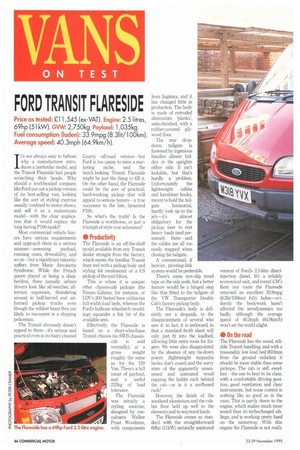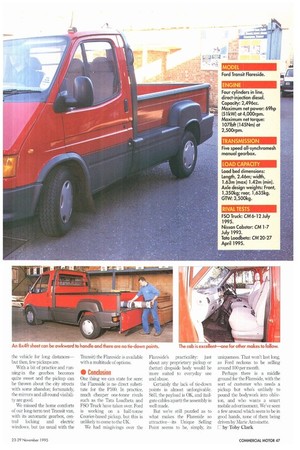FORD TRANSIT FLARESIDE
Page 48

Page 49

If you've noticed an error in this article please click here to report it so we can fix it.
Price as tested: El 1,545 (ex-VAT). Engine: 2.5 litres, 69hp (51kW). GVW: 2,750kg. Payload: 1,035kg. Fuel consumption (laden): 33.9mpg (8.314/100km). Average speed: 40.3mph (64.9km/h).
It's not always easy to fathom why a manufacturer introduces a particular model, and the Transit Flareside had people scratching their heads. Why should a level-headed company like Ford put out a pickup version of its best-selling van, looking like the sort of styling exercise usually confined to motor shows, and sell it as a mainstream model—with the clear implication that it would replace the long-lasting P100 model?
Most commercial vehicle buyers have serious requirements and approach them in a serious manner—assessing payload, running costs, driveability, and so on—but a significant minority suffers from Marie Antoinette Syndrome. While the French queen played at being a shepherdess, these (usually urban) drivers look like all-weather, allterrain supermen, thundering around in bull-barred and airhorned pickup trucks even though the wildest beast they are likely to encounter is a sleeping policeman.
The Transit obviously doesn't appeal to them—it's serious and practical even in its hairy-chested County off-road version—but Ford is too canny to miss a mar keting niche, and the butch-looking Transit Flareside might be just the thing to fill it. On the other hand, the Flareside could be the sort of practical, hard-working pickup that will appeal to serious buyersa true successor to the late, lamented P100.
So what's the truth? Is the Flareside a workhorse, or just a triumph of style over substance?
• Productivity
The Flareside is an off-the-shelf model available from any Transit dealer straight from the factory, which mates the familiar Transit front end with a pickup body and styling kit reminiscent of a US pickup of the mid-fifties.
This is where it is unique: other chassis-cab pickups (the Nissan Cabstar, for instance, or LDV's 200 Series) have utilitarian full-width load beds, whereas the Ford's bulbous wheelarch mouldings squander a fair bit of the available area Effectively, the Flareside is based on a short-wheelbase Transit chassis (no SWB chassiscab is sold normally), at a gross weight roughly the same as for the 120 Van. There's a full tonne of payload, and a useful 235kg of load tolerance.
The Flareside was initially a styling exercise, designed by consultants Walker Praat Woodman, with components from Ingimex, and it has changed little in production. The body is made of extruded aluminium 'planks', satin-finished, with a rubber-covered plywood floor.
The rear dropdown tailgate is fastened by ingenious handles almost hidden in the uprights either side. It isn't lockable, but that's hardly a problem. Unfortunately the lightweight cables and karabiner hooks, meant to hold the tail gate horizontal, hardly look up to the job—it's almost obligatory for the pickup user to rest heavy loads (and personnel) there—and the cables are all too easily trapped when closing the tailgate.
A conventional, if heavier, pivoting-link system would be preferable.
There's some non-slip tread tape on the side pods, but a better feature would be a hinged step like that fitted to the tailgate of the VW Transporter Double Cab's factory pickup body.
The Flareside's body is definitely not a dropside, to the disappointment of several who saw it: in fact, it is awkward, in that a standard 8x4ft sheet will only just fit into the loadbed, allowing little extra room for fingers. We were also disappointed by the absence of any tie-down points (lightweight tarpaulin hooks don't count) and the sorry state of the apparently unseasoned and untreated wood capping the ladder rack behind the cab or is it a surfboard rack?
However, the finish of the anodised aluminium and the rubber floor held up well to the elements and to wayward loads.
The Flareside comes as standard with the straightforward 69hp (51kW) naturally aspirated
version of Ford's 2.5-litre directinjection diesel. It's a reliably economical unit, and round CM'S Kent test route the Flareside returned an excellent 33.9mpg (8.314/1001un) fully laden—evidently the bodywork hasn't affected the aerodynamics too badly, although the average speed of 40.3mph (64.9km/h) won't set the world alight.
• On the road
The Flareside has the usual, reliable Transit handling, and with a reasonably low load bed (810rrun from the ground unladen) it should be more stable than some pickups. The cab is still excellent—the one to beat in its class, with a comfortable driving position, good ventilation and clear instruments, but noise control is nothing like as good as in the vans. This is partly down to the engine, which makes much more sound than its turbocharged siblings, and is working pretty hard on the motorway. With this engine the Flareside is not really the vehicle for long distances but then, few pickups are.
With a bit of practice and running-in the gearbox becomes quite sweet and the pickup can be thrown about the city streets with some abandon; fortunately, the mirrors and all-round visibility are good, We missed the home comforts of our long-term-test Transit van, with its automatic gearbox, central locking and electric windows. but (as usual with the Transit) the Flareside is available with a multitude of options.
• Conclusion One thing we can state for sure: the Flareside is no direct substitute for the P100. In practice, much cheaper one-tonne rivals such as the Tata Loadbeta and FSO Truck have taken over. Ford is working on a half-tonne Courier-based pickup, but this is unlikely to come to the UK.
We had misgivings over the Flareside's practicality: just about any proprietary pickup or (better) clropside body would be more suited to everyday use and abuse.
Certainly the lack of tie-down points is almost unforgivable. Still, the payload is OK, and (tailgate cables apart) the assembly is well made.
But were still puzzled as to what makes the Flareside so attractive—its Unique Selling Point seems to be, simply, its
uniqueness. That won't last long, as Ford reckons to be selling around 100 per month.
Perhaps there is a middle ground for the Flareside, with the sort of customer who needs a pickup but who's unlikely to pound the bodywork into oblivion, and who wants a smart mobile advertisement, We've seen a few around which seem to be in good hands, none of them being driven by Marie Antoinette.
F. by Toby Clark












































































































